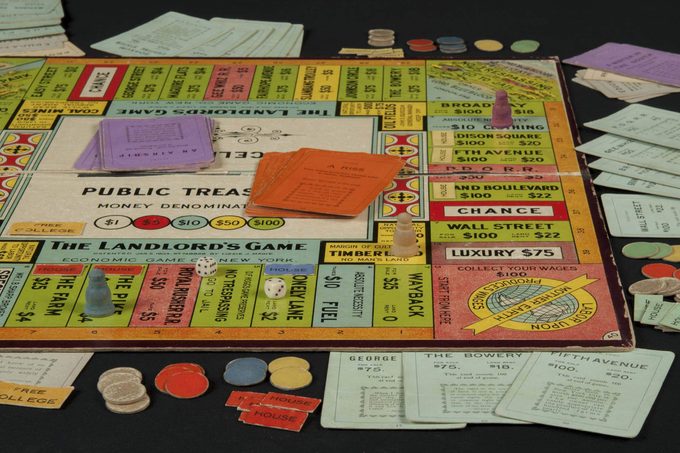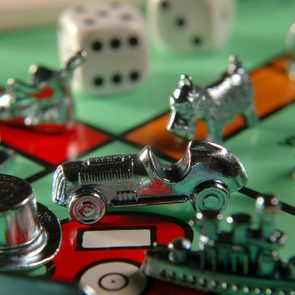There was a jail, and you did collect money when you passed Go, but the game's origins may surprise you

This Is What the First-Ever Monopoly Game Looked Like

You may know Monopoly as one of the most popular classic board games in modern history, or as the game that means your family members all stop talking to each other for a couple of hours over Thanksgiving. But did you know it was initially invented as a way to educate people about the social implications of wealth, not to buy and sell fictitious real estate?
The original Monopoly game was released in 1906, and it looked very different from the version on your shelf (or computer) today. In fact, it didn’t even have the same name. Keep reading, because we uncovered everything you need to know about the first Monopoly game.
Get Reader’s Digest’s Read Up newsletter for more humor, cleaning, travel, tech and fun facts all week long.

The first Monopoly game was called The Landlord’s Game
Here’s a fun fact: The first version of the game wasn’t called Monopoly. A young woman by the name of Elizabeth Magie created the game as a “practical demonstration of the present system of land-grabbing with all its usual outcomes and consequences.”
Her inspiration was a book by progressive economist Henry George, called Progress and Poverty. The first version of the game was called The Landlord’s Game. Whereas the original goal of the game was to simply accumulate wealth, the goal in the eventual Monopoly version was to own industry and create a monopoly of wealth and influence.
If you’re getting flashbacks of the despair you felt as your uncle cackled maniacally when you and your last $100 landed on his three-hotel property, well, that’s sort of the point of the game (the despair, not the cackling). Which is maybe why some people today prefer to play online board games instead.
The first Monopoly game was a teaching tool
Researcher Thomas Forsyth has spent the last 20 years researching the history of The Landlord’s Game. “Elizabeth [Magie] saw a concentration of the nation’s wealth with a small minority of people and wanted a way to teach people that it not only would grow worse if left alone, but that solutions existed to remedy the problem.” She hoped the game would solve those problems by illustrating their effects and making it personal (at least in gaming terms).
As time went on, The Landlord’s Game was played in classrooms to teach students about the economy. They added new rules and changed the board around, with the name evolving from The Landlord’s Game to Auction Monopoly to finally just Monopoly.
Parker Brothers soon bought the patent, and sales for the game exploded. Since then, multiple newer versions of the original Monopoly game have been published. And true to the game’s intent, there’s money to be made from some of them.

How much are original Monopoly games worth?
Because Monopoly was such a successful game, there were thousands of copies sold, which means thousands potentially still survive. Even games from the 1930s don’t tend to sell for jaw-dropping prices (they’re under $50). But there are some collectors’ and rare editions that are worth a bit more.
These include the Parker Brothers Patent Pending 1935 Edition (worth $300 to $900), the Parker Brothers 1935 Trade Mark edition (worth $380 to $1,000) and the 1991 Last Edition, given out only to employees of a manufacturing plant in Salem, Massachusetts, when Hasbro took over the game. Only 650 copies of this game were produced, and they fetch more than $2,000.
You can still buy replicas of the first Monopoly game
Additionally, Forsyth has started to sell replicas of the original Monopoly game on his website, which looks just like Magie’s first release of The Landlord’s Game. “Right now we see history repeating itself with a great concentration of wealth, so it really is a perfect time to revisit a release of the original game after more than 100 years of solitude,” says Forsyth.
Now that you have a deeper understanding of this unexpectedly educational game, you’ll be better equipped to play—and win at—Monopoly at your next family gathering.

Why trust us
At Reader’s Digest, we’re committed to producing high-quality content by writers with expertise and experience in their field in consultation with relevant, qualified experts. We rely on reputable primary sources, including government and professional organizations and academic institutions as well as our writers’ personal experiences where appropriate. We verify all facts and data, back them with credible sourcing and revisit them over time to ensure they remain accurate and up to date. Read more about our team, our contributors and our editorial policies.
Sources:
- Landlords Game: “History”
- Landlords Game: “1906 Replica Edition Game”
- The Gamer: “Rarest Monopoly Versions”























